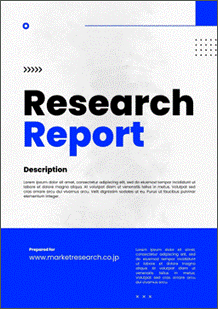 | • レポートコード:MRC2304G108 • 出版社/出版日:Mordor Intelligence / 2023年2月 • レポート形態:英文、PDF、160ページ • 納品方法:Eメール(受注後2-3営業日) • 産業分類:食品 |
| Single User | ¥665,000 (USD4,750) | ▷ お問い合わせ |
| Corporate License | ¥1,225,000 (USD8,750) | ▷ お問い合わせ |
• お支払方法:銀行振込(納品後、ご請求書送付)
レポート概要
| Mordor Intelligence社の市場調査レポートによると、世界のオーガニック飲料市場規模が予測期間中にCAGR 13%拡大すると見られています。本レポートでは、オーガニック飲料の世界市場を調査対象とし、イントロダクション、調査手法、エグゼクティブサマリー、市場動向、製品種類別(アルコール飲料、ノンアルコール飲料)分析、流通チャネル別(スーパーマーケット/大型スーパーマーケット、コンビニエンスストア、専門小売業者、オンライン小売業者、その他)分析、地域別(アメリカ、カナダ、メキシコ、スペイン、イギリス、ドイツ、フランス、イタリア、ロシア、中国、日本、インド、オーストラリア、ブラジル、アルゼンチン、南アフリカ、UAE)分析、競争状況、市場機会・将来動向などを整理しました。並びに、市場調査の対象企業には、Anheuser-Busch InBev、Drake's Organic Spirits LLC、PS Organic, LLC、James White Drinks、Nestlé SA、PepsiCo Inc.、Danone SA、Whitewave Foods Company、Bison Organic Beer、Lacorata Beverage LLC.、SYSTM Foods Inc.、Organic Valleyなどが含まれています。 ・イントロダクション ・調査手法 ・エグゼクティブサマリー ・市場動向 ・世界のオーガニック飲料市場規模:製品種類別 - アルコール飲料の市場規模 - ノンアルコール飲料の市場規模 ・世界のオーガニック飲料市場規模:流通チャネル別 - スーパーマーケット/大型スーパーマーケットチャネルの市場規模 - コンビニエンスストアチャネルの市場規模 - 専門小売業者チャネルの市場規模 - オンライン小売業者チャネルの市場規模 - その他チャネルの市場規模 ・世界のオーガニック飲料市場規模:地域別 - 北米のオーガニック飲料市場規模 アメリカのオーガニック飲料市場規模 カナダのオーガニック飲料市場規模 メキシコのオーガニック飲料市場規模 … - ヨーロッパのオーガニック飲料市場規模 スペインのオーガニック飲料市場規模 イギリスのオーガニック飲料市場規模 ドイツのオーガニック飲料市場規模 … - アジア太平洋のオーガニック飲料市場規模 中国のオーガニック飲料市場規模 日本のオーガニック飲料市場規模 インドのオーガニック飲料市場規模 … - 南米/中東のオーガニック飲料市場規模 ブラジルのオーガニック飲料市場規模 アルゼンチンのオーガニック飲料市場規模 南アフリカのオーガニック飲料市場規模 … ・競争状況 ・市場機会・将来動向 |
The Organic Beverage Market is projected to register a CAGR of 13% over the forecast period.
The market studied is driven by the growing awareness among consumers to limit exposure to harmful chemicals used in conventional beverage production and the rising awareness of the benefits of organic products. Additionally, the market studied is driven by the trend toward clean-label products and cleaner diets. Consumers across the world are increasingly reaching for fresher and healthier food and beverage options for themselves. Another key trend observed in the market studied is innovative packaging and the use of organic ingredients that have significant health benefits, primarily focused on cognitive and physical development.
Organic beverages can help in improving the health conditions of the gut by maintaining the balance of the intestine and increasing immunity. Hence, there is an increasing demand for pure and natural ingredients in organic beverages, which has led the key players in the market to expand their product offerings with an extensive range of authentic fruit-based organic drinks. In addition to growing consumer demand for non-sweet, non-caffeinated beverages, the availability of new flavors and ingredients like turmeric, aloe Vera, and activated charcoal in attractive, easy-to-carry packaging and in-store packaging is likely to contribute to the growth of the organic beverage industry.
Organic Beverage Market Trends
Health-conscious consumers are increasingly demanding organic beverages
Globally, there is an increase in demand for organic beverages as consumers are becoming health-conscious and prefer beverages that are free from flavoring agents, preservatives, and synthetic pesticide-free. With changing consumer tastes and health benefits, consumers are increasingly interested in innovative and evolving flavors. Instead of drinking other carbonated drinks, consumers are switching to organic beverages. Organic fruits and vegetable juice are becoming more popular due to their high nutrient content.
Manufacturers are focusing on new product developments by bringing various blends of organic flavors to attract the consumer base. For instance, in January 2022, Drake’s Organic Spirits introduced a new BOXTAIL flavor: Drake’s Perfect Margarita BOXTAIL. It joins Drake’s line of ready-to-drink (RTD) cocktails including the Minted Mojito, Watermelon-Tini, Mango Punch, and Black Cherry Limeade. Further, with an increase in supportive policies from various countries toward organic business, the market for organic beverages is expected to grow further during the forecast period.
North America is the Largest Market
North America remains to be the largest market for organic beverages due to the shift in consumer interest toward natural and clean-label products. In the United States, organic products, including beverages, have shifted from being a lifestyle choice to being consumed at least occasionally by the majority of Americans. Organic fruit and vegetable juices continued to perform well as consumers become more aware of the growing process as well as certifications such as USDA, which is driving them to go for beverages from organic sources rather than conventional ones. With the number of private-label beverage manufacturers entering the segment, the market for organic beverages is projected to grow further during the forecast period. Moreover, Increasing awareness levels for organic products among consumers and continuous launches of new product variants are expected to support the organic beverage market across the North American region.
Organic Beverage Market Competitor Analysis
Anheuser-Busch InBev, Nestle SA, PepsiCo (Lipton), Danone SA (Horizon Organic), and Parkers Organic Juices are the major companies that are operating in this market. These companies are embarking on mergers and acquisitions and new product developments as their key strategies to strengthen their positions and optimize their offerings, respectively. For instance, Danone acquired WhiteWave to expand its product portfolio for dairy products. Further, the acquisition will strengthen the company’s product line with brands, including Horizon Organic milk.
Additional Benefits:
- The market estimate (ME) sheet in Excel format
- 3 months of analyst support
1 INTRODUCTION
1.1 Study Assumptions and Market Definition
1.2 Scope of the Study
2 RESEARCH METHODOLOGY
3 EXECUTIVE SUMMARY
4 MARKET DYNAMICS
4.1 Market Drivers
4.2 Market Restraints
4.3 Porter’s Five Forces Analysis
4.3.1 Bargaining Power of Suppliers
4.3.2 Bargaining Power of Buyers/Consumers
4.3.3 Threat of New Entrants
4.3.4 Threat of Substitute Products
4.3.5 Intensity of Competitive Rivalry
5 MARKET SEGMENTATION
5.1 Product Type
5.1.1 Alcoholic
5.1.1.1 Wine
5.1.1.2 Beer
5.1.1.3 Spirits
5.1.1.4 Other Alcoholic Beverages
5.1.2 Non-alcoholic
5.1.2.1 Fruit and Vegetable Juices
5.1.2.2 Dairy
5.1.2.3 Coffee and Tea
5.1.2.4 Other Non-alcoholic Beverages
5.2 Distribution Channel
5.2.1 Supermarkets/Hypermarkets
5.2.2 Convenience Stores
5.2.3 Specialist Retailers
5.2.4 Online Retailers
5.2.5 Other Distribution Channels
5.3 Geography
5.3.1 North America
5.3.1.1 United States
5.3.1.2 Canada
5.3.1.3 Mexico
5.3.1.4 Rest of North America
5.3.2 Europe
5.3.2.1 Spain
5.3.2.2 United Kingdom
5.3.2.3 Germany
5.3.2.4 France
5.3.2.5 Italy
5.3.2.6 Russia
5.3.2.7 Rest of Europe
5.3.3 Asia-Pacific
5.3.3.1 China
5.3.3.2 Japan
5.3.3.3 India
5.3.3.4 Australia
5.3.3.5 Rest of Asia-Pacific
5.3.4 South America
5.3.4.1 Brazil
5.3.4.2 Argentina
5.3.4.3 Rest of South America
5.3.5 Middle-East
5.3.5.1 South Africa
5.3.5.2 United Arab Emirates
5.3.5.3 Rest of Middle-East
6 COMPETITIVE LANDSCAPE
6.1 Most Adopted Strategies
6.2 Market Share Analysis
6.3 Company Profiles
6.3.1 Anheuser-Busch InBev
6.3.2 Drake’s Organic Spirits LLC
6.3.3 PS Organic, LLC
6.3.4 James White Drinks
6.3.5 Nestlé SA
6.3.6 PepsiCo Inc.
6.3.7 Danone SA
6.3.8 Whitewave Foods Company
6.3.9 Bison Organic Beer
6.3.10 Lacorata Beverage LLC.
6.3.11 SYSTM Foods Inc.
6.3.12 Organic Valley
7 MARKET OPPORTUNITIES AND FUTURE TRENDS
